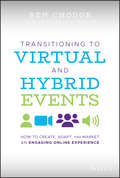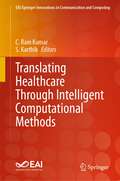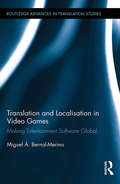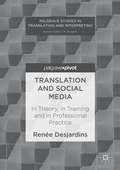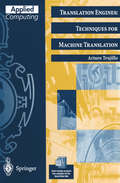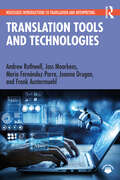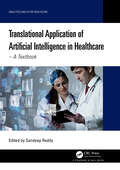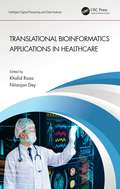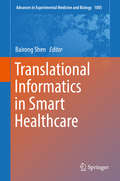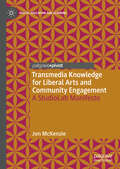- Table View
- List View
Transitioning to Virtual and Hybrid Events: How to Create, Adapt, and Market an Engaging Online Experience
by Ben ChodorCreating virtual events is not as simple as moving the same content online — learn how to immediately leverage virtual solutions for effective in-person online events As the global COVID-19 pandemic continues to have unprecedented impact on both the global economy and the whole of the world population, the need for effectively and efficiently connecting people and the right information has never been more urgent. Although the technology infrastructure currently exists, many organizations are scrambling to create virtual meetings and events to address important time-sensitive issues. Transitioning to Virtual and Hybrid Events explains everything an event host needs to know about going virtual, from understanding the new audience, to adapting content to the new medium, to marketing effectively, and much more. Author Ben Chodor, president of Intrado Digital Media, provides expert advice and real-world instructions for delivering engaging hybrid, virtual, and streaming events and webinars for companies of all sizes and across all industries. Packed with detailed tutorials, real-world case studies, illustrative examples, and highly useful checklists, this comprehensive resource provides step-by-step guidance on: Planning, creating, and implementing a digital event Choosing between a stream, a webcast, or a hybrid event Evaluating different technological solutions Producing compelling virtual content for a variety of scenarios Effectively promoting online events Meeting the needs of a diverse and global audience Transitioning to Virtual and Hybrid Events is an indispensable instruction manual for anyone tasked with enhancing their organization’s continuity plans, enabling their employee base to work remotely, or creating any type of virtual solution to meet this urgent crisis.
Transitioning to Virtual and Hybrid Events: How to Create, Adapt, and Market an Engaging Online Experience
by Ben ChodorCreating virtual events is not as simple as moving the same content online — learn how to immediately leverage virtual solutions for effective in-person online events As the global COVID-19 pandemic continues to have unprecedented impact on both the global economy and the whole of the world population, the need for effectively and efficiently connecting people and the right information has never been more urgent. Although the technology infrastructure currently exists, many organizations are scrambling to create virtual meetings and events to address important time-sensitive issues. Transitioning to Virtual and Hybrid Events explains everything an event host needs to know about going virtual, from understanding the new audience, to adapting content to the new medium, to marketing effectively, and much more. Author Ben Chodor, president of Intrado Digital Media, provides expert advice and real-world instructions for delivering engaging hybrid, virtual, and streaming events and webinars for companies of all sizes and across all industries. Packed with detailed tutorials, real-world case studies, illustrative examples, and highly useful checklists, this comprehensive resource provides step-by-step guidance on: Planning, creating, and implementing a digital event Choosing between a stream, a webcast, or a hybrid event Evaluating different technological solutions Producing compelling virtual content for a variety of scenarios Effectively promoting online events Meeting the needs of a diverse and global audience Transitioning to Virtual and Hybrid Events is an indispensable instruction manual for anyone tasked with enhancing their organization’s continuity plans, enabling their employee base to work remotely, or creating any type of virtual solution to meet this urgent crisis.
Translating Euclid: Designing a Human-Centered Mathematics (Synthesis Lectures on Human-Centered Informatics)
by GERRY STAHLTranslating Euclid reports on an effort to transform geometry for students from a stylus-and-clay-tablet corpus of historical theorems to a stimulating computer-supported collaborative-learning inquiry experience. The origin of geometry was a turning point in the pre-history of informatics, literacy, and rational thought. Yet, this triumph of human intellect became ossified through historic layers of systematization, beginning with Euclid’s organization of the Elements of geometry. Often taught by memorization of procedures, theorems, and proofs, geometry in schooling rarely conveys its underlying intellectual excitement. The recent development of dynamic-geometry software offers an opportunity to translate the study of geometry into a contemporary vernacular. However, this involves transformations along multiple dimensions of the conceptual and practical context of learning. Translating Euclid steps through the multiple challenges involved in redesigning geometry education to take advantage of computer support. Networked computers portend an interactive approach to exploring dynamic geometry as well as broadened prospects for collaboration. The proposed conception of geometry emphasizes the central role of the construction of dependencies as a design activity, integrating human creation and mathematical discovery to form a human-centered approach to mathematics. This book chronicles an iterative effort to adapt technology, theory, pedagogy and practice to support this vision of collaborative dynamic geometry and to evolve the approach through on-going cycles of trial with students and refinement of resources. It thereby provides a case study of a design-based research effort in computer-supported collaborative learning from a human-centered informatics perspective.
Translating Healthcare Through Intelligent Computational Methods (EAI/Springer Innovations in Communication and Computing)
by C. Ram Kumar S. KarthikThis book provides information on interdependencies of medicine and telecommunications engineering and how Covid exemplifies how the two must rely on each other to effectively function in this era. The book discusses new techniques for medical service improvisation such as clear cut views on medical technologies. The authors provide chapters on processing of medical amenities using medical images, the importance of data and information technology in medicine, and machine learning and artificial intelligence in healthcare. Authors include researchers, academics, and professionals in the field of communications engineering with a variety of perspectives.
Translating Systems Thinking into Practice: A Guide to Developing Incident Reporting Systems
by Natassia Goode Paul M. Salmon Michael Lenne Caroline FinchSystems thinking tells us that human error, violations and technology failures result from poorly designed and managed work systems. To help us understand and prevent injuries and incidents, incident reporting systems must be capable of collecting data on contributory factors from across the overall work system, in addition to factors relating to the immediate context of the event (e.g. front-line workers, environment, and equipment). This book describes how to design a practical, usable incident reporting system based on this approach. The book contains all the information needed to effectively design and implement a new incident reporting system underpinned by systems thinking. It also provides guidance on how to evaluate and improve existing incident reporting systems so they are practical for users, collect good quality data, and reflect the principles of systems thinking. Features Highlights the key principles of systems thinking for designing incident reporting systems Outlines a process for developing and testing incident reporting systems Describes how to evaluate incident reporting systems to ensure they are practical, usable, and collect good quality data Provides detailed guidance on how to analyze incident data, and translate the findings into appropriate incident prevention strategies
Translating Systems Thinking into Practice: A Guide to Developing Incident Reporting Systems
by Natassia Goode Paul M. Salmon Michael Lenne Caroline FinchSystems thinking tells us that human error, violations and technology failures result from poorly designed and managed work systems. To help us understand and prevent injuries and incidents, incident reporting systems must be capable of collecting data on contributory factors from across the overall work system, in addition to factors relating to the immediate context of the event (e.g. front-line workers, environment, and equipment). This book describes how to design a practical, usable incident reporting system based on this approach. The book contains all the information needed to effectively design and implement a new incident reporting system underpinned by systems thinking. It also provides guidance on how to evaluate and improve existing incident reporting systems so they are practical for users, collect good quality data, and reflect the principles of systems thinking. Features Highlights the key principles of systems thinking for designing incident reporting systems Outlines a process for developing and testing incident reporting systems Describes how to evaluate incident reporting systems to ensure they are practical, usable, and collect good quality data Provides detailed guidance on how to analyze incident data, and translate the findings into appropriate incident prevention strategies
Translation and Localisation in Video Games: Making Entertainment Software Global (Routledge Advances in Translation and Interpreting Studies)
by Miguel Á. Bernal-MerinoThis book is a multidisciplinary study of the translation and localisation of video games. It offers a descriptive analysis of the industry – understood as a global phenomenon in entertainment – and aims to explain the norms governing present industry practices, as well as game localisation processes. Additionally, it discusses particular translation issues that are unique to the multichannel nature of video games, in which verbal and nonverbal signs must be cohesively combined with interactivity to achieve maximum playability and immerse players in the game’s virtual world. Although positioned within the theoretical framework of descriptive translation studies, Bernal-Merino incorporates research from audiovisual translation, software localisation, computer assisted translation, comparative literature, and video game production. Moving beyond this framework, Translation and Localisation in Video Games challenges some of the basic tenets of translation studies and proposes changes to established and unsatisfactory processes in the video game and language services industries.
Translation and Localisation in Video Games: Making Entertainment Software Global (Routledge Advances in Translation and Interpreting Studies)
by Miguel Á. Bernal-MerinoThis book is a multidisciplinary study of the translation and localisation of video games. It offers a descriptive analysis of the industry – understood as a global phenomenon in entertainment – and aims to explain the norms governing present industry practices, as well as game localisation processes. Additionally, it discusses particular translation issues that are unique to the multichannel nature of video games, in which verbal and nonverbal signs must be cohesively combined with interactivity to achieve maximum playability and immerse players in the game’s virtual world. Although positioned within the theoretical framework of descriptive translation studies, Bernal-Merino incorporates research from audiovisual translation, software localisation, computer assisted translation, comparative literature, and video game production. Moving beyond this framework, Translation and Localisation in Video Games challenges some of the basic tenets of translation studies and proposes changes to established and unsatisfactory processes in the video game and language services industries.
Translation and Social Media: In Theory, in Training and in Professional Practice (Palgrave Studies in Translating and Interpreting)
by Renée DesjardinsOffering a discussion of translation and social media through three themes, theory, training and professional practice, this book builds on emerging research in Translation Studies, including references citing recent translation and social media industry data. Topics include the translation of hashtags and the relevance of indexing, among others.
Translation, Brains and the Computer: A Neurolinguistic Solution to Ambiguity and Complexity in Machine Translation (Machine Translation: Technologies and Applications #2)
by Bernard ScottThis book is about machine translation (MT) and the classic problems associated with this language technology. It examines the causes of these problems and, for linguistic, rule-based systems, attributes the cause to language’s ambiguity and complexity and their interplay in logic-driven processes. For non-linguistic, data-driven systems, the book attributes translation shortcomings to the very lack of linguistics. It then proposes a demonstrable way to relieve these drawbacks in the shape of a working translation model (Logos Model) that has taken its inspiration from key assumptions about psycholinguistic and neurolinguistic function. The book suggests that this brain-based mechanism is effective precisely because it bridges both linguistically driven and data-driven methodologies. It shows how simulation of this cerebral mechanism has freed this one MT model from the all-important, classic problem of complexity when coping with the ambiguities of language. Logos Model accomplishes this by a data-driven process that does not sacrifice linguistic knowledge, but that, like the brain, integrates linguistics within a data-driven process. As a consequence, the book suggests that the brain-like mechanism embedded in this model has the potential to contribute to further advances in machine translation in all its technological instantiations.
Translation Engines: Techniques for Machine Translation (Applied Computing)
by Arturo TrujilloMachine translation (MT) is the area of computer science and applied linguistics dealing with the translation of human languages such as English and German. MT on the Internet has become an important tool by providing fast, economical and useful translations. With globalisation and expanding trade, demand for translation is set to grow.Translation Engines covers theoretical and practical aspects of MT, both classic and new, including: - Character sets and formatting languages - Translation memory - Linguistic and computational foundations - Basic computational linguistic techniques - Transfer and interlingua MT - Evaluation Software accompanies the text, providing readers with hands on experience of the main algorithms.
Translation Group and Particle Representations in Quantum Field Theory (Lecture Notes in Physics Monographs #40)
by Hans-Jürgen BorchersAt the time I learned quantum field theory it was considered a folk theo rem that it is easy to construct field theories fulfilling either the locality or the spectrum condition. The construction of an example for the latter case is particularly easy. Take for instance an irreducible representation of the Poincare group with positive energy, and as an algebra of observables all compact operators in that representation space. This algebra of observables is even an asymptotically Abelian algebra. Since it has only a single repre sentation - except for multiples of this one - it is hardly possible to replace locality in order to obtain a theory with a reasonable physical structure. This example shows that it is not sufficient to replace locality by asymptotic Abelian-ness. The construction of a theory fulfilling locality without a pos itive energy representation was first done by Doplicher, Regge, and Singer [DRS]. However, modern investigations on the locality ideal in the algebra oftest functions, started by Alcantara and Yngvason [AY], seem to indicate that this is a general feature; this means that most of the algebras of ob servables fulfilling the locality condition will not have representations that also fulfil the spectrum condition. This discussion shows that quantum field theory becomes a subject of interest only if both conditions are satisfied at the same time.
Translation Quality Assessment: From Principles to Practice (Machine Translation: Technologies and Applications #1)
by Joss Moorkens Sheila Castilho Federico Gaspari Stephen DohertyThis is the first volume that brings together research and practice from academic and industry settings and a combination of human and machine translation evaluation. Its comprehensive collection of papers by leading experts in human and machine translation quality and evaluation who situate current developments and chart future trends fills a clear gap in the literature. This is critical to the successful integration of translation technologies in the industry today, where the lines between human and machine are becoming increasingly blurred by technology: this affects the whole translation landscape, from students and trainers to project managers and professionals, including in-house and freelance translators, as well as, of course, translation scholars and researchers. The editors have broad experience in translation quality evaluation research, including investigations into professional practice with qualitative and quantitative studies, and the contributors are leading experts in their respective fields, providing a unique set of complementary perspectives on human and machine translation quality and evaluation, combining theoretical and applied approaches.
Translation Tools and Technologies (Routledge Introductions to Translation and Interpreting)
by Andrew Rothwell Joss Moorkens María Fernández-Parra Joanna Drugan Frank AustermuehlTo trainee translators and established professionals alike, the range of tools and technologies now available, and the speed with which they change, can seem bewildering. This state-of-the-art, copiously illustrated textbook offers a straightforward and practical guide to translation tools and technologies. Demystifying the workings of computer-assisted translation (CAT) and machine translation (MT) technologies, Translation Tools and Technologies offers clear step-by-step guidance on how to choose suitable tools (free or commercial) for the task in hand and quickly get up to speed with them, using examples from a wide range of languages. Translator trainers will also find it invaluable when constructing or updating their courses. This unique book covers many topics in addition to text translation. These include the history of the technologies, project management, terminology research and corpora, audiovisual translation, website, software and games localisation, and quality assurance. Professional workflows are at the heart of the narrative, and due consideration is also given to the legal and ethical questions arising from the reuse of translation data. With targeted suggestions for further reading at the end of each chapter to guide users in deepening their knowledge, this is the essential textbook for all courses in translation and technology within translation studies and translator training. Additional resources are available on the Routledge Translation Studies Portal.
Translation Tools and Technologies (Routledge Introductions to Translation and Interpreting)
by Andrew Rothwell Joss Moorkens María Fernández-Parra Joanna Drugan Frank AustermuehlTo trainee translators and established professionals alike, the range of tools and technologies now available, and the speed with which they change, can seem bewildering. This state-of-the-art, copiously illustrated textbook offers a straightforward and practical guide to translation tools and technologies. Demystifying the workings of computer-assisted translation (CAT) and machine translation (MT) technologies, Translation Tools and Technologies offers clear step-by-step guidance on how to choose suitable tools (free or commercial) for the task in hand and quickly get up to speed with them, using examples from a wide range of languages. Translator trainers will also find it invaluable when constructing or updating their courses. This unique book covers many topics in addition to text translation. These include the history of the technologies, project management, terminology research and corpora, audiovisual translation, website, software and games localisation, and quality assurance. Professional workflows are at the heart of the narrative, and due consideration is also given to the legal and ethical questions arising from the reuse of translation data. With targeted suggestions for further reading at the end of each chapter to guide users in deepening their knowledge, this is the essential textbook for all courses in translation and technology within translation studies and translator training. Additional resources are available on the Routledge Translation Studies Portal.
Translational Application of Artificial Intelligence in Healthcare: - A Textbook (Analytics and AI for Healthcare)
by Sandeep ReddyIn the era of 'Algorithmic Medicine', the integration of Artificial Intelligence (AI) in healthcare holds immense potential to address critical challenges faced by the industry. Drawing upon the expertise and experience of the authors in medicine, data science, medical informatics, administration, and entrepreneurship, this textbook goes beyond theoretical discussions to outline practical steps for transitioning AI from the experimental phase to real-time clinical integration. Using the Translational Science methodology, each chapter of the book concisely and clearly addresses the key issues associated with AI implementation in healthcare. Covering technical, clinical, ethical, regulatory, and legal considerations, the authors present evidence-based solutions and frameworks to overcome these challenges. Engaging case studies and a literature review of peer-reviewed studies and official documents from reputed organizations provide a balanced perspective, bridging the gap between AI research and actual clinical practice.
Translational Application of Artificial Intelligence in Healthcare: - A Textbook (Analytics and AI for Healthcare)
In the era of 'Algorithmic Medicine', the integration of Artificial Intelligence (AI) in healthcare holds immense potential to address critical challenges faced by the industry. Drawing upon the expertise and experience of the authors in medicine, data science, medical informatics, administration, and entrepreneurship, this textbook goes beyond theoretical discussions to outline practical steps for transitioning AI from the experimental phase to real-time clinical integration. Using the Translational Science methodology, each chapter of the book concisely and clearly addresses the key issues associated with AI implementation in healthcare. Covering technical, clinical, ethical, regulatory, and legal considerations, the authors present evidence-based solutions and frameworks to overcome these challenges. Engaging case studies and a literature review of peer-reviewed studies and official documents from reputed organizations provide a balanced perspective, bridging the gap between AI research and actual clinical practice.
Translational Bioinformatics Applications in Healthcare (Intelligent Signal Processing and Data Analysis)
by Khalid Raza Nilanjan DeyTranslational bioinformatics (TBI) involves development of storage, analytics, and advanced computational methods to harvest knowledge from voluminous biomedical and genomic data into 4P healthcare (proactive, predictive, preventive, and participatory). Translational Bioinformatics Applications in Healthcare offers a detailed overview on concepts of TBI, biological and clinical databases, clinical informatics, and pertinent real-case applications. It further illustrates recent advancements, tools, techniques, and applications of TBI in healthcare, including Internet of Things (IoT) potential, toxin databases, medical image analysis and telemedicine applications, analytics of COVID-19 CT images, viroinformatics and viral diseases, and COVID-19–related research. Covers recent technologies such as Blockchain, IoT, and Big data analytics in bioinformatics Presents the role of translational bioinformatic methods in the field of viroinformatics, as well as in drug development and repurposing Includes translational healthcare and NGS for clinical applications Illustrates translational medicine systems and their applications in better healthcare Explores medical image analysis with focus on CT images and novel coronavirus disease detection Aimed at researchers and graduate students in computational biology, data mining and knowledge discovery, algorithms and complexity, and interdisciplinary fields of studies, including bioinformatics, health-informatics, biostatistics, biomedical engineering, and viroinformatics. Khalid Raza is an Assistant Professor, the Department of Computer Science, Jamia Millia Islamia (Central University), New Delhi. His research interests include translational bioinformatics, computational intelligence methods and its applications in bioinformatics, viroinformatics, and health informatics. Nilanjan Dey is an Associate Professor, the Department of Computer Science and Engineering, JIS University, Kolkata, India. His research interests include medical imaging, machine learning, computer-aided diagnosis, and data mining.
Translational Bioinformatics Applications in Healthcare (Intelligent Signal Processing and Data Analysis)
by Khalid Raza Nilanjan DeyTranslational bioinformatics (TBI) involves development of storage, analytics, and advanced computational methods to harvest knowledge from voluminous biomedical and genomic data into 4P healthcare (proactive, predictive, preventive, and participatory). Translational Bioinformatics Applications in Healthcare offers a detailed overview on concepts of TBI, biological and clinical databases, clinical informatics, and pertinent real-case applications. It further illustrates recent advancements, tools, techniques, and applications of TBI in healthcare, including Internet of Things (IoT) potential, toxin databases, medical image analysis and telemedicine applications, analytics of COVID-19 CT images, viroinformatics and viral diseases, and COVID-19–related research. Covers recent technologies such as Blockchain, IoT, and Big data analytics in bioinformatics Presents the role of translational bioinformatic methods in the field of viroinformatics, as well as in drug development and repurposing Includes translational healthcare and NGS for clinical applications Illustrates translational medicine systems and their applications in better healthcare Explores medical image analysis with focus on CT images and novel coronavirus disease detection Aimed at researchers and graduate students in computational biology, data mining and knowledge discovery, algorithms and complexity, and interdisciplinary fields of studies, including bioinformatics, health-informatics, biostatistics, biomedical engineering, and viroinformatics. Khalid Raza is an Assistant Professor, the Department of Computer Science, Jamia Millia Islamia (Central University), New Delhi. His research interests include translational bioinformatics, computational intelligence methods and its applications in bioinformatics, viroinformatics, and health informatics. Nilanjan Dey is an Associate Professor, the Department of Computer Science and Engineering, JIS University, Kolkata, India. His research interests include medical imaging, machine learning, computer-aided diagnosis, and data mining.
Translational Biomedical Informatics: A Precision Medicine Perspective (Advances in Experimental Medicine and Biology #939)
by Bairong Shen Haixu Tang Xiaoqian JiangThis book introduces readers to essential methods and applications in translational biomedical informatics, which include biomedical big data, cloud computing and algorithms for understanding omics data, imaging data, electronic health records and public health data. The storage, retrieval, mining and knowledge discovery of biomedical big data will be among the key challenges for future translational research. The paradigm for precision medicine and healthcare needs to integratively analyze not only the data at the same level – e.g. different omics data at the molecular level – but also data from different levels – the molecular, cellular, tissue, clinical and public health level. This book discusses the following major aspects: the structure of cross-level data; clinical patient information and its shareability; and standardization and privacy. It offers a valuable guide for all biologists, biomedical informaticians and clinicians with an interest in Precision Medicine Informatics.
Translational Informatics in Smart Healthcare (Advances in Experimental Medicine and Biology #1005)
by Bairong ShenThis book is about the transformation of the biomedical information to smart healthcare, the chapters are designed to discuss the health associated factors such as genetics, lifestyle, nutrition and environmental factors. The interactions of these factors and the informatics for the analyses of their effects on health are also covered. The era of aging is approaching and the P4 (predictive, preventive, personalized and participatory) medicine paradigm is becoming practical and reality. According to the Kondratiev's long wave theory, IT (information technology) and health will be the next technological revolution for the new economic cycle. This book is written for biomedical informatics scientists, clinicians, health practitioners and researchers, etc.
Translational Recurrences: From Mathematical Theory to Real-World Applications (Springer Proceedings in Mathematics & Statistics #103)
by Norbert Marwan Michael Riley Alessandro Giuliani Charles L. WebberThis book features 13 papers presented at the Fifth International Symposium on Recurrence Plots, held August 2013 in Chicago, IL. It examines recent applications and developments in recurrence plots and recurrence quantification analysis (RQA) with special emphasis on biological and cognitive systems and the analysis of coupled systems using cross-recurrence methods.Readers will discover new applications and insights into a range of systems provided by recurrence plot analysis and new theoretical and mathematical developments in recurrence plots. Recurrence plot based analysis is a powerful tool that operates on real-world complex systems that are nonlinear, non-stationary, noisy, of any statistical distribution, free of any particular model type and not particularly long. Quantitative analyses promote the detection of system state changes, synchronized dynamical regimes or classification of system states.The book will be of interest to an interdisciplinary audience of recurrence plot users and researchers interested in time series analysis of complex systems in general.
Translator’s Workbench: Tools and Terminology for Translation and Text Processing (Research Reports Esprit #1)
by Marianne Kugler Khurshid Ahmad Gregor ThurmairThe Translator's Workbench Project was a European Community sponsored research and development project which dealt with issues in multi-lingual communication and docu mentation. This book presents an integrated toolset as a solution to problems in translation and docu mentation. Professional translators and teachers of translation were involved in the proc ess of software development, starting with a detailed study of the user requirements and ending with several evaluation-and-improvement cycles of the resulting toolset. English, German, Greek, and Spanish are addressed in the contributions, however, some of the techniques are inherently language-independent and can thus be extended to cover other languages as well. Translation can be viewed broadly as the execution of three cognitive processes, and this book has been structured along these lines: • First, the translation pre-process, understanding the target language text at a lexico semantic level on the one hand, and making sense of the source language document on the other hand. The tools for the pre-translation process include access to electronic networks, conversion of documents from one format to another, creation of terminol ogy data banks and access to existing data banks, and terminology dictionaries. • Second, the translation process, rendering sentences in the source language into equiva lent target sentences. The translation process refers to the potential of conventional machine translation systems, like METAL, and of the statistically oriented translation memory.
Transmedia Knowledge for Liberal Arts and Community Engagement: A StudioLab Manifesto (Digital Education and Learning)
by Jon McKenzieThis book sets forth a pedagogy for renewing the liberal arts by combining critical thinking, media activism, and design thinking. Using the StudioLab approach, the author seeks to democratize the social and technical practices of digital culture just as nineteenth century education sought to democratize literacy. This production of transmedia knowledge—from texts and videos to comics and installations—moves students between seminar, studio, lab, and field activities. The book also wrestles with the figure of Plato and the very medium of knowledge to re-envision higher education in contemporary societies, issuing a call for community engagement as a form of collective thought-action.
Transmedia Storytelling and the New Era of Media Convergence in Higher Education
by Stavroula KalogerasStories, whether they are fact or fiction, popular or not, are a proven method of pedagogy. In the age of media convergence and with the advancement of technology, stories have morphed into new forms; however, their core purpose remains the same, which is to pass on knowledge and information. The internet, with its inherent interactivity, and story, with its inherent capacity to engage, can lead to innovative and transformative learning experiences in media-rich environments. This book focuses on web-based Transmedia Storytelling Edutainment (TmSE) as an andragogical practice in higher education. Story is at the forefront of this investigation because narrative is the basis for developing entertainment media franchise that can be incorporated into pedagogical practice. The propulsion of this analysis consists of practice-based research through narrative inquiry and an e-module case study presented on multimedia storytelling in the classroom. A Transmedia Storytelling Framework is provided for creating screenplays for cross-media projects and for analyzing their appropriateness in education. Additionally, a hypertext screenplay, which allowed students to dig deeper into the story word and to build more knowledge, is evaluated for its use in higher education. Since screenplays are by nature writing for the screen, it is believed that the more visual the input, the more likely it is to be memorized and recalled.A link to The Goddess Within screenplay is available for download on the right hand side of this page.
